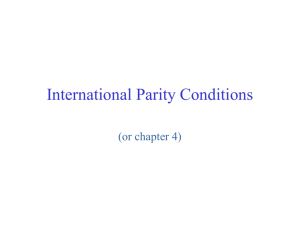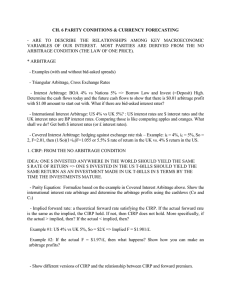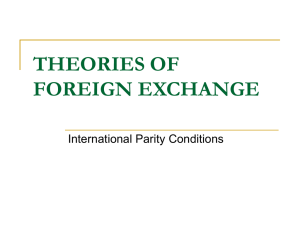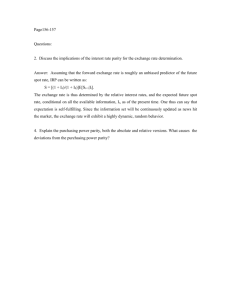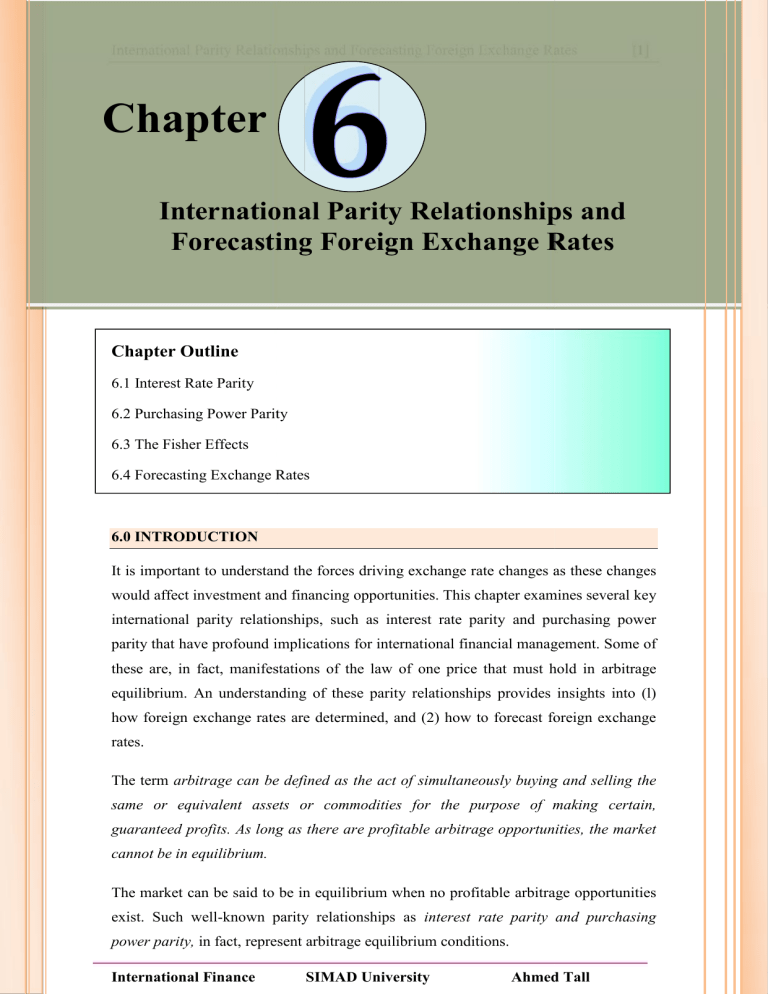
International Parity Relationships and Forecasting Foreign Exchange Rates [1] Chapter International Parity Relationships and Forecasting Foreign Exchange Rates Chapter Outline 6.1 Interest Rate Parity 6.2 Purchasing Power Parity 6.3 The Fisher Effects 6.4 Forecasting Exchange Rates 6.0 INTRODUCTION It is important to understand the forces driving exchange rate changes as these changes would affect investment and financing opportunities. This chapter examines several key international parity relationships, such as interest rate parity and purchasing power parity that have profound implications for international financial management. Some of these are, in fact, manifestations of the law of one price that must hold in arbitrage equilibrium. An understanding of these parity relationships provides insights into (l) how foreign exchange rates are determined, and (2) how to forecast foreign exchange rates. The term arbitrage can be defined as the act of simultaneously buying and selling the same or equivalent assets or commodities for the purpose of making certain, guaranteed profits. As long as there are profitable arbitrage opportunities, the market cannot be in equilibrium. The market can be said to be in equilibrium when no profitable arbitrage opportunities exist. Such well-known parity relationships as interest rate parity and purchasing power parity, in fact, represent arbitrage equilibrium conditions. International Finance SIMAD University Ahmed Tall [2] International Parity Relationships and Forecasting Foreign Exchange Rates 6.1 INTEREST RATE PARITY Interest rate parity (IRP) is an arbitrage condition that must hold when international financial markets are in equilibrium. Interest rate parity (IRP) holds forward premium or discount should be equal to the interest rate differential between two countries.IRP represents an arbitrage equilibrium that should hold in the absence of barriers to international capital flows. If IRP is violated, one can make profit by borrowing in one currency and lending in another with exchange risk hedged via forward contract.IRP implies that in short run, the exchange rate depends on (a) relative interest rates between two countries (b) the expected future exchange rate. Arbitrage equilibrium then would dictate that the future dollar proceeds (or, equivalently, the dollar interest rates) from investing in the two equivalent investments must be the same, implying that (1 + ) = (1 + ) or F= Example 1 Covered Interest Arbitrage (Page 141-142) Suppose that the annual interest rate is 5 percent in the United States and 8 percent in the U.K., and that the spot exchange rate is $1.80/£ and the forward exchange rate, with one-year maturity, is $1.78/£. In terms of our notation, i$ = 5%, i£ = 8%, S = $1.80, and F = $1.78. Assume that the arbitrager can borrow up to $1,000,000 or £555,556, which is equivalent to $1,000,000 at the current spot exchange rate. Solution Step 1: Checking if IRP is holding under current market conditions F= $1.78 > 1.80 . . and $1.78 > $1.75 or (1 + ) = (1 + )in which 1.05 < 1.068 Clearly, IRP is not holding, implying that a profitable arbitrage opportunity exists. Since the interest rate is lower in the United States, an arbitrage transaction should involve borrowing in the United States and lending in the U.K. The arbitrager can carry out the following transactions: International Finance SIMAD University Ahmed Tall International Parity Relationships and Forecasting Foreign Exchange Rates [3] 1. In the United States, borrow $1,000,000. Repayment in one year will be $1,050,000 = $1,000,000 x 1.05. 2. Buy £555,556 spot using $1,000,000. 3. Invest £555,556 in the U.K. The maturity value will be £600,000 = £555,556 x 1.08. 4. Sell £600,000 forward in exchange for $1, 068,000 = (£600,000)($1.78/£). 5. The arbitrage profit $1,068,000 - $1,050,000=$18,000 How long will this arbitrage opportunity last? A simple answer is: only for a short while. As soon as deviations from IRP are detected, informed traders will immediately carry out CIA transactions. As a result of these arbitrage activities, IRP will be restored quite quickly. To see this, let's get back to our numerical example, which induced covered interest arbitrage activities. Since every trader will (1) borrow in the United States as much as possible, (2) lend in the U.K., (3) buy the pound spot, and, at the same time, (4) sell the pound forward, the following adjustments will occur to the initial market condition: 1. The interest rate will rise in the United States (i$ ↑). 2. The interest rate will fall in the U.K. (i£↓ ) 3. The pound will appreciate in the spot market (S↑). 4. The pound will depreciate in the forward market (F ↓). Example 2 Consider the following set of foreign and domestic interest rates and spot and forward exchange rates and the amount of money you may borrow $1,000. Spot exchange rate(S) $2.00 360-day forward rate(F) $2.01 U.S. discount rate(Ih) British discount rate (If) 3% 2.49% Solution Step One: A trader with $1,000 could invest in the U.S. at 3%, in one year and his investment will be worth = $1,000 (1.03) = $1,030 Step Two: Exchange $1,000 for £500 at the prevailing spot rate of $2 International Finance SIMAD University Ahmed Tall International Parity Relationships and Forecasting Foreign Exchange Rates [4] £1= $2 X= $1000 therefore, x= £500 Step Three: Invest £500 for one year at If = 2.49%, a. The amount that will be received= 500(1+2.49%) = £512.45 b. Sign a forward contract at rate of $2.01 Step Four: Reconvert £512.45 back into dollars at the forward rate F= $2.01, the £512.45 will be worth of $1,030. Step Five: therefore, IRP holds and CIA is not possible Example 3: Covered Interest Arbitrage The spot exchange rate is $1.50/£ and the three-month forward exchange rate is $1.52/£. The three-month interest rate is 8.0% per annum in the U.S. and 5.8% per annum in the U.K. Assume that you can borrow as much as $1,500,000 or £1,000,000. a. Determine whether the interest rate parity is currently holding. b. If the IRP is not holding, how would you carry out covered interest arbitrage? c. Show all the steps and determine the arbitrage profit. d. Explain how the IRP will be restored as a result of covered arbitrage activities. Solution S = $1.5/£ F = $1.52/£ Ih = 2.0% If = 1.45% Proceed = $1,500,000 or £1,000,000. a. (1+Ih) = (1+If)(F/S) = (1.0145)(1.52/1.50) 1.02 <1.0280, thus, IRP is not holding exactly. b. Strategy Step (1): Borrow $1,500,000 and repayment will be $1,530,000. Repayment= 1,500,000 (1+0.02) = $1,530,000. Step (2): convert $1,500,000, at S = $1.5 £1= $1.5 International Finance SIMAD University Ahmed Tall International Parity Relationships and Forecasting Foreign Exchange Rates [5] X= 1,500,000 Then x= £1,000,000 Step (3): Invest this amount £1,000,000 at the interest rate of 1.45%. a. The amount that you will receive= £1,000,000 (1+0.0145) = £1,014,500. b. Sign a forward contract with F = $1.52 Step (4): Reconvert this amount at £1,014,500 at rate of F = $1.52 £1= $1.52 £1,014,500 = x Then x= $1,542,040 Step 5: Calculation of Arbitrage Profit Arbitrage= $1,542,040-$1,530,000= $12040 Therefore the arbitrage profit will be $12,040 c. Followings are the arbitrage transactions described below. i. The dollar interest rate will rise. ii. The pound interest rate will fall. iii. The spot exchange rate will rise. iv. The forward exchange rate will fall. These adjustments will continue until IRP holds. Interest Rate Parity and Exchange Rate Determination IRP has an immediate implication for exchange rate determination. An arbitrage in equilibrium condition involves the (spot) exchange rate. The forward exchange rate is an important factor in spot exchange rate determination. Under certain conditions the forward exchange rate can be viewed as the expected future spot exchange rate. Where St+1 is the future spot rate when the forward contract matures, and It denotes the set of information currently available. International Finance SIMAD University Ahmed Tall International Parity Relationships and Forecasting Foreign Exchange Rates [6] Currency Carry Trade Unlike IRP, the uncovered interest rate parity often doesn't hold, giving rise to uncovered interest arbitrage opportunities. A popular example of such trade is provided by currency carry trade. Currency carry trade involves buying a high-yielding currency and funding it with a low-yielding currency, without any hedging. 6.2 PURCHASING POWER PARITY When the law of one price is applied internationally to a standard commodity basket, we obtain the theory of purchasing power parity (PPP). This theory states that the exchange rate between currencies of two countries should be equal to the ratio of the countries' price levels. The exchange rate between two currencies should equal the ratio of the countries’ price levels. = When the country’s inflation rises, the demand of its currency and exports decline and consumers and firms increase imports. Both of these forces place downward pressure on high inflation country’s currency. The purchasing power parity (PPP) theory attempts to quantify the inflation exchange rate relationship. There are two popular techniques: 1. Absolute PPP that states that similar products in different countries should be priced equally when measured in common currency. 2. Relative PPP that accounts for imperfections like transportation costs, tariffs and quotas. It states that the rate of price changes should be similar. = − + = ( + ) ef = % ∆ of foreign currency value, IH = home inflation If = foreign inflation IH > If , ef > 0 ⇒ FC appreciates ,IH < If , ef < 0 ⇒ FC depreciates International Finance SIMAD University Ahmed Tall International Parity Relationships and Forecasting Foreign Exchange Rates [7] Example 4 Ih= 5% = If = 3% + + − Interpretation = ef =? + . + . − = . % The foreign currency should appreciate 1.94% to high inflation of home country with respect to foreign country. Price index of both countries should rise 5% according to home country. Example 5 IH = 4% = + + If = 7% − Interpretation = + . + . ef =? − =− . % The foreign currency should depreciate 2.8% to high inflation of home country with respect to foreign country. Price index of both countries rises 4% according to home country. Price index of both countries rises 4% according to home country. Purchasing power parity doesn’t hold. Purchasing power parity doesn’t consistently occur because of confounding effect and lack of substitutes for some traded goods. i. Confounding Effect PPP theory presumes that exchange rates are completely driven by inflation differentials between two countries but there are some other factors, such as: a. Interest rate b. Income level c. Government controls d. Change in expectation of future exchange ii. Lack of substitutes for traded goods The idea behind PPP theory is as soon as prices become high in one country. The consumers in another country buying imported goods and shift to domestic goods. This International Finance SIMAD University Ahmed Tall International Parity Relationships and Forecasting Foreign Exchange Rates [8] shift influences exchange rate. If substitute goods are not available domestically, the consumers may not stop buying imported goods. Evidence on PPP 1. PPP probably doesn’t hold precisely in the real world for a variety of reasons. a. Haircuts cost 10 times as much in the developed world as in the developing world. b. Film, on the other hand, is a highly standardized commodity that is actively traded across borders. c. Shipping costs, as well as tariffs and quotas can lead to deviations from PPP. 2. PPP-determined exchange rates still provide a valuable benchmark. Implications of Purchasing Power Parity If exchange rate changes satisfy PPP, competitive positions of countries will remain unaffected following exchange rate changes. Otherwise, exchange rate changes will affect relative competitiveness of countries. If a country’s currency appreciates (depreciates) by more than is warranted by PPP that will hurt (strengthen) the country’s competitive position in the world market. 6.3 FISHER EFFECTS Fisher’s effect states an increase (decrease) in the expected rate of inflation will cause a proportionate increase (decrease) in the interest rate in the country. The Fisher effect is written as: 1 + i$ = (1 + $ ) × E(1 + $) Where $ is the equilibrium expected “real” U.S. interest rate E($) is the expected rate of U.S. inflation i$ is the equilibrium expected nominal U.S. interest rate International Fisher Effect International fisher effect (IFE) uses interest rates rather than inflation rates but it is closely related with PPP theory because interest rates are highly correlated with inflation rates. According to IFE theory, nominal interest rates contain real rate of return and anticipated inflation. International Finance SIMAD University Ahmed Tall International Parity Relationships and Forecasting Foreign Exchange Rates [9] IFE theory states that currencies with high interest rates will depreciate because higher interest rates reflect higher expected inflation. Investors who hope to capitalize on higher foreign interest rates should earn return no better than what they have earned domestically. + + = = − IH > If , ef > 0 ⇒ FC appreciates IH < If , ef < 0 ⇒ FC depreciates , − IH = home interest , If = foreign interest Example 6 Ih = 11% = ef = ? If = 12% + + Interpretation − + . + . = − =− . % The foreign currency depreciates by 0.89% to make actual return on foreign deposit equal to the 11 percent in the home country. Example 7: International Fishers Effect and exchange rate St = $0.85 = = + + ( + Interpretation , − If = 4%, = ) ∴ + . + . IH = 3% , − =− . St+1=? %≈− . = $0.85[1 + (−0.0196)] = $0.8415 The Canadian dollar should depreciate by 0.01 and the expected future spot rate of CD$ is $0.8415 Example 8: International Fishers Effect and exchange rate P#5: St = $0.90 = 1+ 1+ = IH=6% −1= (1 + Interpretation ) If=5%+6%=11% 1 + 0.06 − 1 = +0.045 1 + 0.11 ⟹ $0.90[1 − 0.045] = $0.8595 The foreign currency depreciates by 0.045 and new spot rate is $0.8595 International Finance SIMAD University Ahmed Tall International Parity Relationships and Forecasting Foreign Exchange Rates [10] 6.4 FORECASTING EXCHANGE RATES 1. Efficient Markets Approach Financial Markets are efficient if prices reflect all available and relevant information. 2. Fundamental Approach involves econometrics to develop models that use a variety of explanatory variables. This involves three steps: a. step 1: Estimate the structural model. b. step 2: Estimate future parameter values. c. step 3: Use the model to develop forecasts. 3. Technical Approach Technical analysis looks for patterns in the past behavior of exchange rates. 4. Performance of the Forecasters a. Forecasting is difficult, especially with regard to the future. b. As a whole, forecasters cannot do a better job of forecasting future exchange rates than the forward rate. c. The founder of Forbes Magazine once said: “You can make more money selling financial advice than following it.” Comparison among IRP, PPP and IFE key variables of Summarized Theory theory theory Interest rate parity (IRP) Forward rate Premium ( discount) Interest rate differential Percentage change of spot rate Inflation rate differential The forward rate of one currency to another will contain premium or discount that is determined by differential in interest rates between two countries. As a result, the covered interest arbitrage will provide return that in not higher than domestic return. Purchasing power parity (PPP) The spot rate of one currency with respect to another currency will change in reaction to differential in inflation rates between two countries. Consequently, the purchasing power for consumers when purchasing goods in their own country should be similar when importing goods from foreign country. International Fisher Effect (IFE) Percentage change of Spot rate The spot rate of one currency with respect to another currency will change in reaction differential in interest rates between two countries consequently. The return on foreign money market will be no higher than return on domestic money market. International Finance SIMAD University Interest rate differential Ahmed Tall International Parity Relationships and Forecasting Foreign Exchange Rates [11] PROBLEMS Question One Suppose that the treasurer of IBM has an extra cash reserve of $1,000,000 to invest for six months. The six-month interest rate is 8% per annum in the U.S. and 6% per annum in Germany. Currently, the spot exchange rate is DM1.60 per dollar and the six-month forward exchange rate is DM1.56 per dollar. The treasurer of IBM does not wish to bear any exchange risk. Where should he/she invest to maximize the return? Ans: $16,410 and it is better to invest $1,000,000 in Germany with exchange risk hedging Question Two While you were visiting London, you purchased a Jaguar for £35,000, payable in three months. You have enough cash at your bank in New York City, which pays 0.35% interest per month, compounding monthly, to pay for the car. Currently, the spot exchange rate is $1.45/£ and the three-month forward exchange rate is $1.40/£. In London, the money market interest rate is 2.0% for a three-month investment. There are two alternative ways of paying for your Jaguar. a) Keep the funds at your bank in the U.S. and buy £35,000 forward. b) Buy a certain pound amount spot today and invest the amount in the U.K. for three months so that the maturity value becomes equal to £35,000.Evaluate each payment method. Which method would you prefer? Why? Ans: a. The cost of Jaguar as of today is $48,489 b. $1,266 Question Three Suppose that the current spot exchange rate is FF6.25/$ and the three-month forward exchange rate is FF6.28/$. The three-month interest rate is 5.6% per annum in the U.S. and 8.8% per annum in France. Assume that you can borrow up to $1,000,000 or FF 6,250,000. a. Show how to realize a certain profit via covered interest arbitrage, assuming that you want to realize profit in terms of U.S. dollars. Also determine the magnitude of International Finance SIMAD University Ahmed Tall International Parity Relationships and Forecasting Foreign Exchange Rates [12] arbitrage profit. b. Assume that you want to realize profit in terms of French francs. Show the covered arbitrage process and determine the arbitrage profit in French francs. Ans: a) Arbitrage profit will be $3,118 b) Arbitrage profit will be FF19, 580 Question Four In the issue of October 23, 1999, the Economist reports that the interest rate per annum is 5.93% in the United States and 70.0% in Turkey. Why do you think the interest rate is so high in Turkey? Based on the reported interest rates, how would you predict the change of the exchange rate between the U.S. dollar and the Turkish lira? Ans: The Turkish lira thus is expected to depreciate against the U.S. dollar by about 64%. Question Five As of November 1, 1999, the exchange rate between the Brazilian real and U.S. dollar is R$1.95/$. The consensus forecast for the U.S. and Brazil inflation rates for the next 1-year period is 2.6% and 20.0%, respectively. How would you forecast the exchange rate to be at around November 1, 2000? Ans: R$2.29/$ International Finance SIMAD University Ahmed Tall



